Group Project ECO558 PDF

| Title | Group Project ECO558 |
|---|---|
| Author | Anis Syuhada |
| Course | Monetary Economics |
| Institution | Universiti Teknologi MARA |
| Pages | 19 |
| File Size | 551.8 KB |
| File Type | |
| Total Views | 1,005 |
Summary
BACHELOR OF BUSINESS ADMINISTRATION (HONS.) BUSINESS ECONOMY (BA250)COURSE: ECONOMICS FOR BUSINESS AND MANAGEMENT (ECO558)ASSIGNMENT: GROUP ASSIGNMENTCLASS: D2BA2504APREPARED BY:NO. STUDENT NAME MATRIC ID1 NABILAH BINTI SALIMMI 2020968087 2 ANIS SYUHADA BINTI MOHD ANUAR 2020176075 3 JASMIN AMYSHA AL...
Description
BACHELOR OF BUSINESS ADMINISTRATION (HONS.) BUSINESS ECONOMY (BA250)
COURSE: ECONOMICS FOR BUSINESS AND MANAGEMENT (ECO558)
ASSIGNMENT: GROUP ASSIGNMENT
CLASS: D2BA2504A
PREPARED BY: NO. STUDENT NAME
MATRIC ID
1
NABILAH BINTI SALIMMI
2020968087
2
ANIS SYUHADA BINTI MOHD ANUAR
2020176075
3
JASMIN AMYSHA ALIA IMAN BINTI JAMALLUDDIN
2020952599
PREPARED FOR: MADAM WAN HASNI WAN HASAN
DATE OF SUBMISSION: 15TH JANUARY 2022
Table of Contents 1.0 ABSTRACT ............................................................................................................................... 3 2.0 ACKNOWLEDGEMENT ......................................................................................................... 4 3.0 CONTENTS ............................................................................................................................... 5 3.1 INTRODUCTION & OBJECTIVES .................................................................................... 5 3.2 COEFFICIENT OF EACH VARIABLE .............................................................................. 6 3.3 SIGN OF THE COEFFICIENT ............................................................................................ 7 3.4 T-TEST ..................................................................................................................................... 8 3.5 F-TEST...................................................................................................................................... 9 3.6 COEFFICIENT OF DETERMINATION (R²) ................................................................... 10 3.7 CONCLUSIONS .................................................................................................................. 11 3.8 RECOMMENDATIONS ..................................................................................................... 12 3.9 ELASTICITY ...................................................................................................................... 13
1.0 ABSTRACT Studies have been conducted on Total Sales of Eggs in 31 different states in a country. It is assumed that sales of the egg are depending on four variables which are the number of households in the state, price of egg per tray, total sales of fish, and average income per household. So, to get the regression results, we need to run the analysis using SPSS which is short for Statistical Package Social Sciences, and it is used by various kinds of researchers for complex statistical data analysis. The SPSS software package was created for the management and statistical analysis of social science data. It is used by market researchers, health researchers, survey companies, government entities, education researchers, marketing organizations, data miners, and many more for processing and analyzing survey data, such as you collect with an online survey platform. Also, we need to know the sensitiveness between demand and each of the independent variables to understand the product better. On top of that, we need to check the validity of the model whether it requires improvement or correction. Therefore, in this assignment, we will discuss the demand estimation and its regression analysis.
3
2.0 ACKNOWLEDGEMENT First and foremost, we would like to praise and thank Allah for giving us the strengths. It is because of His blessings, we finally managed to finish this group project. Without His blessings, we would not have gone this far. We had finally completed this group project with great enthusiasm and determination. All the time spent to discuss and search ideas as well as running the analysis were worth our efforts and time, Insha-Allah.
Secondly, we would like to express our gratitude to our lecturer Madam Wan Hasni Wan Hasan for teaching us in subject Economics for Business and Management throughout this semester. Without her guidance, we cannot complete the task smoothly. She always gives us support and guides us on how to do this group project for us to produce a good outcome. She inspired us greatly in this group project. Last but not least, we would like to thank all my friends who never give up in giving their support in completing this group project. This group project cannot be done without the efforts and cooperation from our group members, which are Anis Syuhada binti Mohd Anuar, Nabilah binti Salimmi, and Jasmin Amysha Alia Iman binti Jamalluddin. Despite our busy schedule, we can complete this group project with our full commitment and responsibility.
4
3.0 CONTENTS 3.1 INTRODUCTION & OBJECTIVES Demand estimation is a forecast based on future consumer behavior. It forecasts demand for a company's products or services based on a set of variables such as price changes, a competitor's pricing strategy, or changes in consumer income levels that affect product demand. Managers who estimate demand consider the influence of future price changes on the quantity demanded. Management can use this data to make strategic business decisions such as pricing strategies. Managers must use forecasting and demand estimation to reduce uncertainty. The main goal of this group project is to comprehend the concept of estimating a demand function, understand the process and steps for estimating demand, develop a regression equation, and interpret the SPSS or E-views results. Besides, demand forecasting allows a company to make a variety of business decisions, including planning the manufacturing process, procuring raw materials, managing cash, and determining the product's pricing. So, the objective is to formulate a price policy. An organization determines the price of its items based on demand. When an economy enters a period of depression or recession, for example, the product demand decreases. In this scenario, the company sets low prices for its goods. Furthermore, the objective is to formulate a production policy. It assists in closing the gap between product demand and supply. It also helps in projecting future raw material requirements so that a consistent supply of raw materials can be maintained. It further helps in the most efficient use of resources because operations are scheduled according to forecasts. Similarly, demand forecasting makes it simple to meet human resource needs.
5
3.2 COEFFICIENT OF EACH VARIABLE
Coefficients Standardized Unstandardized Coefficients Model
B
(Constant)
Std. Error
49888.061
1130556.499
225.875
125.734
-211473.850
Total sales of fish ($) Average income per
Number of households in the
Coefficients Beta
t
Sig. .044
.965
.566
1.796
.084
167623.560
-.325
-1.262
.218
-1.768
6.149
-.044
-.287
.776
22.924
6.255
.563
3.665
.001
state Price of egg per tray ($)
households ($) a. Dependent Variable: Total sales of egg ($)
a) Regression equation Sᴇ = βₒ + β₁N - β₂Pᴇ - β₃Sꜰ + β₄Y b) Estimated equation Sᴇ = 49888.061 + 225.875N – 211473.850P ᴇ - 1.768Sꜰ + 22.924Y Where: Sᴇ : Total sales of egg ($) N : Number of households in the state Pᴇ : Price of egg per tray ($) Sꜰ : Total sales of fish ($) Y : Average income per households ($)
c) Coefficient value -
N : Increase in number of households in the state, will increase the total sales of egg by 225.875 units.
-
Pᴇ: Increase in price of egg per tray, will decrease the total sales of egg by 211473.850 units.
-
Sꜰ : Increase in total sales of fish, will decrease the total sales of egg by 1.768 units.
-
Y : Increase in average income per households, will increase the total sales of egg by 22.924 units. 6
3.3 SIGN OF THE COEFFICIENT The correlation between a dependent and an independent variable is described by regression coefficients, which are predictions of unknown population parameters. The coefficients express the mathematical relationship between the independent and dependent variables. So, the direction of the association between a dependent and independent variable is shown by the sign of each coefficient. The sign of the coefficient will determine whether or not the variables follow the theory. A positive sign signifies that as the independent variable rises, so does the dependent variable. Meanwhile, the negative sign signifies that as the independent variable rises, the dependent variable will drop. Therefore, from the regression result, the number of households in the state is showing a positive coefficient. This means that if 1 person increases in the number of households, it will increase the total sales of eggs by 225.875 times. This relationship follows the economic theory because the price and the number of households are positively related. Next, for the price of egg per tray. It is showing a negative coefficient. This indicates that a $1 increase in the price of egg per tray will decrease the total sales of eggs by 211473.850 times. This relationship follows the economic theory because the price and total sales are negatively related. Besides, the total sales of fish also show a negative coefficient which means they are negatively related. For instance, a $1 increase in total sales of fish will decrease the total sales of eggs by 1.768 times. This relationship follows the economic theory because of complementary goods. Then, as for the average income per households, it is showing a positive sign of coefficient. This indicates that a $1 increase in average income per households will increase the total sales of eggs by 22.924. This relationship follows the economic theory because income and total sales are positively related.
7
3.4 T-TE T-TEST ST The T-test is a statistical test that compares two groups' means. It is frequently used in hypothesis testing to see if a method or treatment has an effect on the population of interest, or if two groups differ. A t-test can be performed only when to compare the means of two groups. So, the t-test is calculated by dividing the coefficient by its standard error. It also evaluates whether the dependent and independent variables have a significant relationship. The formula is shown as follows.
T-test
=
|estimated coefficient - the true coefficient| |standard error of coefficient|
Therefore, if the absolute value of the estimated t-test is bigger than the t-table, it indicates that demand and the selected independent variable have a significant relationship. Meanwhile, if the absolute value of the estimated t-test is smaller than the t-table, it indicates that demand and the selected independent variable have no significant relationship. As we can see from the regression result, the t-test is already stated in the table. So, the t-test for the number of households in the state is 1.796 which is slightly smaller than the critical-t, 1.96. It means there is no significant relationship between the number of households in the state and the total sales of eggs. Meanwhile, for the price of egg per tray, the t-test is |– 1.262| also smaller than the critical-t. This also shows that there is no significant relationship between the price of egg per tray and total sales of eggs. Other than that, the t-test for total sales of fish is |– 0.287| and it is less than the criticalt. This indicates that there is no significant relationship between total sales of fish and total sales of eggs as well. In addition, the t-test for the average income per household is 3.665 which is greater than the critical-t. This signifies that there is a significant relationship between average income per household and the total sales of eggs.
8
3.5 F-TES F-TESTT An F-test is a form of statistical test that can be used in a variety of situations that applies the F-distribution. When you run an ANOVA test or a regression analysis to see if the means of two populations are significantly different, you will get this value. The F-test of overall significance tells you if your linear regression model fits the data better than a model with no independent variables. The formula is as follows:
F-test
=
R²/ (k - 1) (1 - R²)/(n - k)
ANOVA Model 1
Sum of Squares Regression Residual Total
1342650594612.210
df
Mean Square 4 335662648653.053
773944946193.725
26
2116595540805.935
30
F 11.276
Sig. .000b
29767113315.143
a. Dependent Variable: Total sales of egg ($) b. Predictors: (Constant), Average income per households ($), Total sales of fish ($), Price of egg per tray ($), Number of households in the state
So, from the ANOVA table, the F-value which is 11.276 is obtained by dividing the Mean Square Regression (3.357E+11) with the Mean Square Residual (2.977E+10). This F value has a modest p-value connected with it which is 0.000. The p-value is compared to the significance level, which is typically set at 0.05. Therefore, the F test is greater than the significance F. As a result, the number of households in the state, price of egg per tray, average income per households, and total sales of fish show a statistically significant relationship with the total sales of eggs.
9
3.6 COEFFICIENT OF DETERMINATION (R²) In the linear regression setting, R² is a metric that evaluates a model's ability to predict or explain a result. More specifically, R² denotes the percentage of the variance in the dependent variable predicted or explained by linear regression and the predictor variable. Generally, a high R² implies that the model is a good fit for the data, though fit interpretations vary depending on the context of the analysis. It shows how effectively the whole regression model explains changes in the dependent variable's value.
As we can see from the result, the value of R² is 0.634, indicates that 63.4% of the variation in total sales of eggs has been explained by the number of households in the state, price of egg per tray, total sales of fish, and average income per households. Another 36.6% cannot be explained by this model. Perhaps another variable has been overlooked.
10
3.7 CONCLUSIONS In conclusion, the strength of the relationship between the model and the dependent variable is reported in the model summary table. The linear correlation between the observed and model-predicted values of the dependent variable is expressed by R, the multiple correlation coefficient. it lies between the limits of -1 and +1, that is, -1 < r < 1. Thus, in this model, it has a high value, 0.796 which indicates a strong relationship. Next, R Square, the coefficient of determination, is explained as the squared value of multiple correlation coefficient. it is a nonnegative quantity. Its limit is 0 < R² < 1. If R² is equal to 0, there is no explanation for the variance in the dependent variable. If R² is equal to 1, it means a perfect fit. Therefore, all variation has been explained by independent variables. In this model, the R² is 0.634 which is not too high. Then, the adjusted R-squared is based upon the samples size and the number of regressors. It is a modified form of R-squared that adjusts for predictors in a regression model that are not significant. To put it another way, the adjusted R-squared illustrates whether adding more factors improves a regression model or not. So, the value in this model is 0.578 which means all the independent variables contribute to explain the dependent variable. In addition, the Durbin-Watson statistic has a range of values between 0 and 4. There is no autocorrelation in the sample with a value of 2.0, positive autocorrelation is shown by values from 0 to less than 2, and negative autocorrelation is represented by a values from 2 to 4. In this model, the Durbin-Watson value is 0.294 which is less than 2. This means this model has a positive autocorrelation.
11
3.8 RECOMMENDATIONS Looking at the performance of the company, I would recommend for the owner to increase the sample size because it is a good decision for them. As can be seen from the data analysis, there is an increase in the total sales of eggs which indicates that there is an increase in the company's profitability. But, if we look at the correlation among the number of households in the state with the price of egg per tray, it is 0.825 which is larger than 0.7. This means that the problem of multicollinearity is there in the model. Hence, we need to increase the sample size to reduce this problem. Therefore, the data will be more accurate with larger sample size. In addition, the consequence of multicollinearity is the value of R² is too high but has few significant independent variables. The R² value may be very high, even if some regression coefficients are statistically insignificant. High R² shows a good fitactual data fit near the regression line. Multicollinearity will have little effect on the overall fit of the regression equation. As a result, forecasting and prediction will be mainly unaffected. So, in this model, the R² is 63.4% but only one independent variable is significant which is the average income per households. To overcome this, we can drop a variable. Moreover, this company is having a problem with heteroscedasticity. Heteroscedasticity is most commonly found in cross-sectional data, which is considered primary data. Also, it occurs when the variance of the error is not constant or maybe due to incorrect data transformation. As the value of an independent variable rises, the errors may rise as well. For instance, in this model which average income per households is the independent variable and total sales of eggs is the dependent variable. Therefore, households with low income will spend relatively little on eggs, and the variations in total sales of eggs will be small. By that, we can either re-specify the model or do a variable transformation to remedy this issue.
12
3.9 ELASTICITY a) Demand elasticity to each of the independent variables: It refers to how sensitive demand for a good is compared to changes in other economic factors such as price or income. There are three types of elasticity of demand which are price elasticity of demand, cross elasticity of demand, and income elasticity of demand.
i.
Price Elasticity of Demand A measure of the effect of a price change on the demand for a product or service. The coefficient for price elasticity of demand is always negative. Therefore, the absolute value will be utilized to evaluate the data. The seller's pricing strategy will be assisted by the degrees of elasticity. The seller's goal is to increase his or her sales revenue. As a result, the seller must decide whether they should drop the price or whether they can afford to raise the price. The formula is shown as follows:
PED
PED
= dQ x P dP Q
=
=
dQ x P dP Q - 211473.850 x 12.3 1060594
=
- 2.45
Since demand is elastic, the seller should lower the price to increase profits. When the price increases by 1%, the quantity demanded decreases by 2.45 %.
13
ii.
Cross Elasticity of Demand It measures the sensitiveness of demand of a product to a change in the price of another good. When good X and good Z are linked, the cross elasticity will determine the rate of change in demand for good Z due to a change in the price of good X. The demand cros...
Similar Free PDFs

Group Project ECO558
- 19 Pages
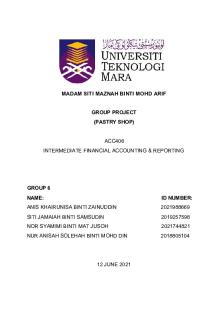
Group Project Account ( Group 6)
- 21 Pages
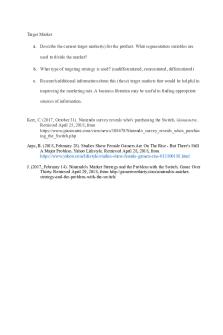
Group Project- Target Market
- 4 Pages
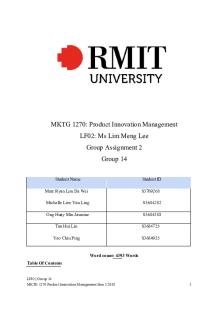
PIM Group Project 2
- 68 Pages
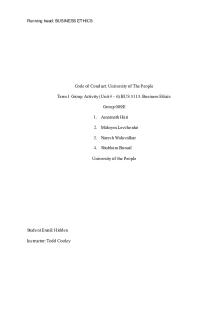
Group Project 009E Final
- 21 Pages
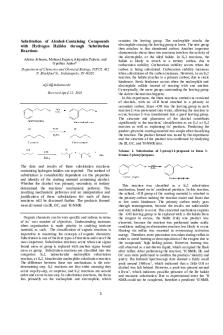
Group Project JOC Note
- 4 Pages

Group Project Proposal
- 1 Pages
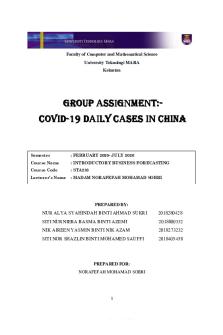
Group Project STA 233
- 33 Pages
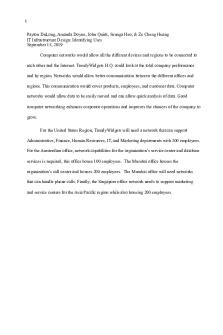
IST Group Project
- 19 Pages

Group project guidelines
- 1 Pages

group project sta108
- 55 Pages

CSR Group Project ASM401
- 18 Pages

MNT group Project
- 9 Pages

Victoria\'s Secret Group Project
- 11 Pages

CSC264 Group Project
- 8 Pages

Project MAT575 Group 1
- 9 Pages
Popular Institutions
- Tinajero National High School - Annex
- Politeknik Caltex Riau
- Yokohama City University
- SGT University
- University of Al-Qadisiyah
- Divine Word College of Vigan
- Techniek College Rotterdam
- Universidade de Santiago
- Universiti Teknologi MARA Cawangan Johor Kampus Pasir Gudang
- Poltekkes Kemenkes Yogyakarta
- Baguio City National High School
- Colegio san marcos
- preparatoria uno
- Centro de Bachillerato Tecnológico Industrial y de Servicios No. 107
- Dalian Maritime University
- Quang Trung Secondary School
- Colegio Tecnológico en Informática
- Corporación Regional de Educación Superior
- Grupo CEDVA
- Dar Al Uloom University
- Centro de Estudios Preuniversitarios de la Universidad Nacional de Ingeniería
- 上智大学
- Aakash International School, Nuna Majara
- San Felipe Neri Catholic School
- Kang Chiao International School - New Taipei City
- Misamis Occidental National High School
- Institución Educativa Escuela Normal Juan Ladrilleros
- Kolehiyo ng Pantukan
- Batanes State College
- Instituto Continental
- Sekolah Menengah Kejuruan Kesehatan Kaltara (Tarakan)
- Colegio de La Inmaculada Concepcion - Cebu